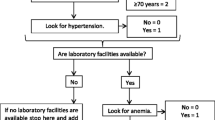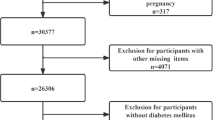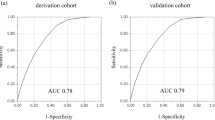Abstract
Purpose
Predictive models allow clinicians to identify higher- and lower-risk patients and make targeted treatment decisions. Microalbuminuria (MA) is a condition whose presence is understood to be an early marker for cardiovascular disease. The aims of this study were to develop a patient data-driven predictive model and a risk-score assessment to improve the identification of MA.
Methods
The 2007–2008 National Health and Nutrition Examination Survey (NHANES) was utilized to create a predictive model. The dataset was split into thirds; one-third was used to develop the model, while the other two-thirds were utilized for internal validation. The 2012–2013 NHANES was used as an external validation database. Multivariate logistic regression was performed to create the model. Performance was evaluated using three criteria: (1) receiver operating characteristic curves; (2) pseudo-R 2 values; and (3) goodness of fit (Hosmer–Lemeshow). The model was then used to develop a risk-score chart.
Results
A model was developed using variables for which there was a significant relationship. Variables included were systolic blood pressure, fasting glucose, C-reactive protein, blood urea nitrogen, and alcohol consumption. The model performed well, and no significant differences were observed when utilized in the validation datasets. A risk score was developed, and the probability of developing MA for each score was calculated.
Conclusion
The predictive model provides new evidence about variables related with MA and may be used by clinicians to identify at-risk patients and to tailor treatment. The risk score developed may allow clinicians to measure a patient’s MA risk.

Similar content being viewed by others
References
Anderson GF, Hussey PS, Frogner BK, Waters HR (2005) Health spending in the United States and the rest of the industrialized world. Health Aff (Proj Hope) 24(4):903–914
Hendriksen JM, Geersing GJ, Moons KG, de Groot JA (2013) Diagnostic and prognostic prediction models. J Thromb Haemost: JTH 11(Suppl 1):129–141. doi:10.1111/jth.12262
Duncan I (2011) Healthcare risk adjustment and predictive modeling. ACTEX Publications, Inc, Winsted, CT
Cousins MS, Shickle LM, Bander JA (2004) An introduction to predictive modeling for disease management risk stratification. Dis Manag 5(3):157–167. doi:10.1089/109350702760301448
OCS (2008) Predictive modeling—to improve outcomes in patients and home care. OCS-leading healthcare insight. http://www.ocshomecare.com/OCSHomeCare/media/OCSHomeCare/Whitepapers/RR_Predicitve_Modeling_08-003.pdf
Wharam JF, Weiner JP (2012) The promise and peril of healthcare forecasting. Am J Manag Care 18(3):e82–e85
Khosla N, Sarafidis PA, Bakris GL (2006) Microalbuminuria. Clin Lab Med 26(3):635–653. doi:10.1016/j.cll.2006.06.005
Scheven L, Van der Velde M, Lambers Heerspink HJ, De Jong PE, Gansevoort RT (2013) Isolated microalbuminuria indicates a poor medical prognosis. Nephrol Dial Transplant 28(7):1794–1801. doi:10.1093/ndt/gft031
Yudkin JS, Forrest RD, Jackson CA (1988) Microalbuminuria as predictor of vascular disease in non-diabetic subjects: islington diabetes survey. Lancet 2(8610):530–533
Bakris GL (1996) Microalbuminuria: prognostic implications. Curr Opin Nephrol Hypertens 5(3):219–223
Hillege HL, Janssen WM, Bak AA, Diercks GF, Grobbee DE, Crijns HJ, Van Gilst WH, De Zeeuw D, De Jong PE, Prevend Study G (2001) Microalbuminuria is common, also in a nondiabetic, nonhypertensive population, and an independent indicator of cardiovascular risk factors and cardiovascular morbidity. J Intern Med 249(6):519–526
Gumbinger C, Sykora M, Diedler J, Ringleb P, Rocco A (2012) Microalbuminuria: a potential prognostic marker for acute stroke. Der Nervenarzt 83(10):1357–1360. doi:10.1007/s00115-012-3678-3
Echouffo-Tcheugui JB, Kengne AP (2012) Risk models to predict chronic kidney disease and its progression: a systematic review. PLoS Med 9(11):e1001344. doi:10.1371/journal.pmed.1001344
Derhaschnig U, Kittler H, Woisetschlager C, Bur A, Herkner H, Hirschl MM (2002) Microalbumin measurement alone or calculation of the albumin/creatinine ratio for the screening of hypertension patients? Nephrol Dial Transplant 17(1):81–85
Sullivan LM, Massaro JM, D’Agostino RB Sr (2004) Presentation of multivariate data for clinical use: the Framingham study risk score functions. Stat Med 23(10):1631–1660. doi:10.1002/sim.1742
Mongkolsomlit S, Rawdaree P, Komoltri C, Tawichasri C, Patumanond J (2012) The development and validation of a risk score for predicting microalbuminuria in type 2 diabetic patients. J Diabetes Mellit 2(2):227–233. doi:10.4236/jdm.2012.22036
Moons KG, Harrell FE, Steyerberg EW (2002) Should scoring rules be based on odds ratios or regression coefficients? J Clin Epidemiol 55(10):1054–1055
Scheven L, Halbesma N, de Jong PE, de Zeeuw D, Bakker SJ, Gansevoort RT (2013) Predictors of progression in albuminuria in the general population: results from the PREVEND cohort. PLoS ONE 8(5):e61119. doi:10.1371/journal.pone.0061119
O’Seaghdha CM, Hwang SJ, Upadhyay A, Meigs JB, Fox CS (2010) Predictors of incident albuminuria in the Framingham offspring cohort. Am J Kidney Dis 56(5):852–860. doi:10.1053/j.ajkd.2010.04.013
Mogensen CE (1984) Microalbuminuria predicts clinical proteinuria and early mortality in maturity-onset diabetes. N Engl J Med 310(6):356–360. doi:10.1056/NEJM198402093100605
Meigs JB, D’Agostino RB Sr, Nathan DM, Rifai N, Wilson PW, Framingham Offspring S (2002) Longitudinal association of glycemia and microalbuminuria: the Framingham offspring study. Diabetes Care 25(6):977–983
Ritz E, Viberti GC, Ruilope LM, Rabelink AJ, Izzo JL Jr, Katayama S, Ito S, Mimran A, Menne J, Rump LC, Januszewicz A, Haller H (2010) Determinants of urinary albumin excretion within the normal range in patients with type 2 diabetes: the randomised olmesartan and diabetes microalbuminuria prevention (ROADMAP) study. Diabetologia 53(1):49–57. doi:10.1007/s00125-009-1577-3
Satchell SC, Tooke JE (2008) What is the mechanism of microalbuminuria in diabetes: a role for the glomerular endothelium? Diabetologia 51(5):714–725. doi:10.1007/s00125-008-0961-8
Pascual JM, Rodilla E, Gonzalez C, Perez-Hoyos S, Redon J (2005) Long-term impact of systolic blood pressure and glycemia on the development of microalbuminuria in essential hypertension. Hypertension 45(6):1125–1130. doi:10.1161/01.HYP.0000167151.52825.11
Eghan BA Jr, Frempong MT, Adjei-Poku M (2007) Prevalence and predictors of microalbuminuria in patients with diabetes mellitus: a cross-sectional observational study in Kumasi, Ghana. Ethn Dis 17(4):726–730
Ganji MR (2013) Albuminuria and management of type 2 diabetes mellitus. Iran J Kidney Dis 7(4):245–248
Ross R (1999) Atherosclerosis–an inflammatory disease. N Engl J Med 340(2):115–126. doi:10.1056/NEJM199901143400207
National Kidney F (2002) K/DOQI clinical practice guidelines for chronic kidney disease: evaluation, classification, and stratification. Am J Kidney Dis 39(2 Suppl 1):S1–S266
Keane WF (2000) Proteinuria: its clinical importance and role in progressive renal disease. Am J Kidney Dis 35(4 Suppl 1):S97–S105
Navarro JF, Mora C, Maca M, Garca J (2003) Inflammatory parameters are independently associated with urinary albumin in type 2 diabetes mellitus. Am J Kidney Dis 42(1):53–61
Stuveling EM, Bakker SJ, Hillege HL, Burgerhof JG, de Jong PE, Gans RO, de Zeeuw D, Group PS (2004) C-reactive protein modifies the relationship between blood pressure and microalbuminuria. Hypertension 43(4):791–796. doi:10.1161/01.HYP.0000120125.08867.42
Sabanayagam C, Lee J, Shankar A, Lim SC, Wong TY, Tai ES (2010) C-reactive protein and microalbuminuria in a multi-ethnic Asian population. Nephrol Dial Transplant 25(4):1167–1172. doi:10.1093/ndt/gfp591
Mojahedi MJ, Bonakdaran S, Hami M, Sheikhian MR, Shakeri MT, Aiatollahi H (2009) Elevated serum C-reactive protein level and microalbuminuria in patients with type 2 diabetes mellitus. Iran J Kidney Dis 3(1):12–16
Author information
Authors and Affiliations
Corresponding author
Ethics declarations
Conflict of interest
The authors declare that they have no conflicts of interest.
Ethical approval
All procedures performed involving patient data in this study were in accordance with the ethical standards of the institutional and/or national research committee.
Rights and permissions
About this article
Cite this article
Villa-Zapata, L., Warholak, T., Slack, M. et al. Predictive modeling using a nationally representative database to identify patients at risk of developing microalbuminuria. Int Urol Nephrol 48, 249–256 (2016). https://doi.org/10.1007/s11255-015-1183-x
Received:
Accepted:
Published:
Issue Date:
DOI: https://doi.org/10.1007/s11255-015-1183-x




